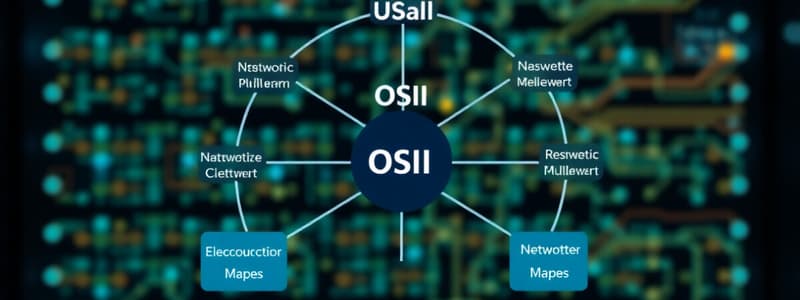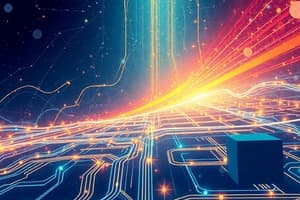Podcast
Questions and Answers
Explain computer networks based on scope, communication type, and connection type.
Explain computer networks based on scope, communication type, and connection type.
A computer network is a collection of interconnected devices, such as computers, servers, and mobile devices, that can share resources and communicate with each other. Scope refers to the geographical area covered by the network, which can be local (LAN), wide area (WAN), or personal (PAN).
Communication type refers to how data is transmitted, which can be either unicast (one-to-one), multicast (one-to-many), or broadcast (one-to-all).
Connection type refers to how devices are connected, which can be wired (using cables) or wireless (using radio waves).
Differentiate between broadcast and point-to-point networks. Give any two important differences.
Differentiate between broadcast and point-to-point networks. Give any two important differences.
Broadcast networks allow data to be sent to all connected devices simultaneously, while point-to-point networks involve direct communication between two specific devices only.
Here are two key differences
- Addressing: Broadcast networks use a single broadcast address for all devices, while point-to-point networks use unique addresses for each device.
- Collision: Broadcast networks are prone to collisions, where multiple devices try to transmit at the same time, while point-to-point networks avoid collisions as only two devices communicate at a time.
What is meant by LAN, WAN, and PAN?
What is meant by LAN, WAN, and PAN?
LAN stands for Local Area Network, a network covering a small geographical area, such as a home, office, or school. A WAN, or Wide Area Network, connects devices over a large geographical area, such as across cities or countries.
Finally, a PAN, or Personal Area Network, is a small wireless network connecting personal devices, such as smartphones, laptops, and tablets, typically within a short range.
What is the OSI Model? List down all the layers and explain any 1 of them.
What is the OSI Model? List down all the layers and explain any 1 of them.
What are the duties of the Physical Layer and Data link layer?
What are the duties of the Physical Layer and Data link layer?
Define the following terms: Amplitude, Frequency, Wavelength, Bitrate, Baud rate, Signal.
Define the following terms: Amplitude, Frequency, Wavelength, Bitrate, Baud rate, Signal.
Short note on Fiber optic cables.
Short note on Fiber optic cables.
Short note on Twisted pair cables.
Short note on Twisted pair cables.
What is Coaxial cable? Compare twisted pair cables and coaxial cables.
What is Coaxial cable? Compare twisted pair cables and coaxial cables.
Explain all the layers of the OSI model.
Explain all the layers of the OSI model.
Differentiate between the OSI and TCP/IP models.
Differentiate between the OSI and TCP/IP models.
List different kinds of Network Software.
List different kinds of Network Software.
Why framing is required? Explain any one method with example.
Why framing is required? Explain any one method with example.
Flashcards
Computer Network Scope
Computer Network Scope
Describes how large a network is, from personal area networks (PANs) to wide area networks (WANs).
Broadcast Network
Broadcast Network
A network where every node receives every transmission.
Point-to-Point Network
Point-to-Point Network
A network where communication occurs between two specific nodes.
LAN (Local Area Network)
LAN (Local Area Network)
Signup and view all the flashcards
WAN (Wide Area Network)
WAN (Wide Area Network)
Signup and view all the flashcards
PAN (Personal Area Network)
PAN (Personal Area Network)
Signup and view all the flashcards
OSI Model
OSI Model
Signup and view all the flashcards
Physical Layer (OSI)
Physical Layer (OSI)
Signup and view all the flashcards
Data Link Layer (OSI)
Data Link Layer (OSI)
Signup and view all the flashcards
Amplitude
Amplitude
Signup and view all the flashcards
Frequency
Frequency
Signup and view all the flashcards
Wavelength
Wavelength
Signup and view all the flashcards
Bitrate
Bitrate
Signup and view all the flashcards
Baud rate
Baud rate
Signup and view all the flashcards
Fiber Optics Cable
Fiber Optics Cable
Signup and view all the flashcards
Twisted Pair Cable
Twisted Pair Cable
Signup and view all the flashcards
Coaxial Cable
Coaxial Cable
Signup and view all the flashcards
TCP/IP Model
TCP/IP Model
Signup and view all the flashcards
Framing
Framing
Signup and view all the flashcards
Byte Stuffing
Byte Stuffing
Signup and view all the flashcards
Bit Stuffing
Bit Stuffing
Signup and view all the flashcards
Sliding Window Protocol
Sliding Window Protocol
Signup and view all the flashcards
Hamming Code
Hamming Code
Signup and view all the flashcards
Piggybacking
Piggybacking
Signup and view all the flashcards
Study Notes
Computer Networks - Unit 1
- Network Types: Computer networks are categorized by scope (e.g., LAN, WAN, PAN), communication type (e.g., broadcast, point-to-point), and connection type
- LAN, WAN, PAN: LANs are local area networks, WANs are wide area networks, and PANs are personal area networks.
- Broadcast vs. Point-to-Point: Broadcast networks send data to all nodes; point-to-point networks send data to a specific node only. Important differences include the destination of messages and the need for intermediary devices
- OSI Model: A layered model describing network communication protocols, listing layers such as Physical, Data Link, Network, Transport, Session, Presentation, Application
- Physical Layer Duties: Physical layer duties include handling signal transmission and reception, dealing with bit rate and signal types
- Data Link Layer Duties: The data link layer handles the reliable transmission of data over a physical link, including framing and error detection/correction
- Fiber Optics and Twisted Pair Cables: Fiber optics cables transmit data using light; twisted pair cables transmit data using electrical signals, comparing advantages & disadvantages of each
- Coaxial Cable: Another type of cable, compare to twisted pair
- OSI & TCP/IP Model Differences: Detailed explanation of the differences between the OSI model and the TCP/IP model
- Network Software: Discuss various categories of network software
- Framing: The process of structuring data into frames for transmission over a data link. Explains why it's necessary & methods with examples (e.g., byte stuffing, bit stuffing)
- Sliding Window Protocol (Go-Back-N): Protocol that manages data transmission, identifying how it handles lost frames, duplicate frames, and lost acknowledgements
- Selective Repeat Protocol: A more advanced sliding window protocol, offering a means for better handling errors. Comparing it to Go-Back-N demonstrates greater efficiency
- Piggybacking: A technique that uses existing acknowledgements to send data
Computer Networks - Unit 2
- Data Link Layer Framing:
- Byte Stuffing
- Bit Stuffing
- Sliding Window Protocol (Go-Back-N):
- Deals with lost frames, duplicate frames, and lost acknowledgements
- Comparing Go-Back-N and Selective Repeat
- Advantages and disadvantages of both
- Hamming Code: Error detection and correction technique
- Stop-and-Wait ARQ Protocol: A simple error-control protocol, highlighting its functionality and drawbacks
- Flow Control Protocols: The regulation of data flow over a network, explaining various protocols (e.g., Stop-and-Wait, Sliding Window)
- Character Count Method and Flag Byte Framing: A disadvantage highlighting how flag byte solves framing problems
- Parity Bits: A simple error detection technique
- Cyclic Redundancy Check (CRC): A method used to detect errors
- Checksum: An error detection method that uses a checksum value to detect if any data has been altered.
- Cumulative vs. Single Acknowledgement: Explain benefits of cumulative acknowledgement over single in terms of handling errors.
Computer Networks - Unit 3 (MAC Protocol)
- Ad-Hoc and Infrastructure Modes: Description of both, highlighting how infrastructure mode differs from ad-hoc mode and different components in each
- ALOHA Protocol: Detailing the protocol, its working principle, along with potential problems & limitations.
- CSMA/CD: Detailing the protocol, its working principle, along with any potential problems and limitations
- Slotted ALOHA: Comparing it to ALOHA. Explaining how slotted ALOHA addresses problems in ALOHA
- Ethernet Frame Structure: Describing the structure; addressing; and components within this structure.
Studying That Suits You
Use AI to generate personalized quizzes and flashcards to suit your learning preferences.




